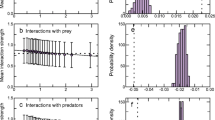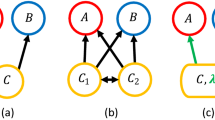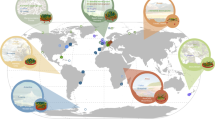Abstract
Many concepts in community ecology suffer from a typological approach to species interactions in which the ecological relationships between species are classified as competitive, mutualistic or predatory; and then they are represented by -/-, +/+, or -/+ pairs of elements in a community matrix. These relationships are often diagramed by a food web that represents the presumed trophic connections among species in a community. Species within a trophic level are assumed to be potential competitors and predators are considered to have a negative effect on the population dynamics of their prey. This negative effect arises from predators decreasing the rate of increase of prey or lowering the equilibrium density of prey. Recently, the simplicities of this approach have been recognized as ecologists have studied multispecies communities with techniques designed to understand mechanisms that structure natural communities. It is now recognized that the interaction between two species can depend on the context in which it is measured (Boucher 1985; Kerfoot and Sih 1986). For example, two species may have a competitive (-/-) interaction when raised in isolation, but show mutualistic (+/+) interaction when a predator is added to the system because the two species spread the risk of predation both benefiting from the presence of the other.
Access this chapter
Tax calculation will be finalised at checkout
Purchases are for personal use only
Preview
Unable to display preview. Download preview PDF.
Similar content being viewed by others
References
Botsford LW (1981) The effects of increased individual growth rates on depressed population size. Am Nat 117:38–63.
Boucher DH (1985) The biology of mutualism. Oxford Univ Press, New York.
Bragg AN (1964) Further studies of predation and cannibalism in spadefoot tadpoles. Herpetologica 20:17–24.
Brooks JL, Dodson SI (1965) Predation, body size, and composition of plankton. Science 150:28–35.
Cerri RD, Fraser DF (1983) Predation and risk in foraging minnows: balancing conflicting demands. Am Nat 121:552–561.
Chambers RC (1984) Competition and predation in temporary habitats. Thesis, Duke Univ, N Car.
Darwin C (1959) The origin of species. Mentor Edition (1958). New Am Libr World Lit, New York.
Errington PL (1946) Predation and vertebrate populations. Q Rev Biol 21:144–177, 221-245.
Fox LR (1975) Cannibalism in natural populations. Annu Rev Ecol Syst 6:87–106.
Fuji K (1965) A statistical model of the competition curve. Res Popul Ecol 7:118–125.
Hairston NG Sr (1986) Species packing in Desmognathus salamanders: experimental demonstration of predation and competition. Am Nat 127:266–291.
Harris JGK (1975) The effect of density-dependent mortality on the shape of the stock and recruitment curve. J Conserv Int Explor Mer 36:144–149.
Harris RN MS Nonlethal injury as a mechanism of population regulation.
Holomuzki JR (1986) Predator avoidance and diel patterns of microhabitat use by larval tiger salamanders. Ecology 67:737–748.
Hrbacek J, Dvorakova M, Korinek V, Prochazkova L (1961) Demonstrations of the effect of the fish stock on species composition of Zooplankton and the intensity of metabolism of the whole plankton association. Verh Int Ver Limnol 14:192–195.
Kerfoot WC, Sih A (1987) Predation: direct and indirect impacts on aquatic communities. Univ Press New Engl, Hannover, NH.
LeCren ED, Kipling C, McCormack JC (1977) A study on the numbers, biomass and year-class strengths of perch (Perca fluviatilis L.) in Windemere from 1941 to 1966. J Anim Ecol 46:281–307.
Lefkovitch LP (1965) The study of population growth in organisms grouped by stages. Biometrics 21:1–18.
Loadman NL, Moodie GEE, Mathias JA (1986) Significance of cannibalism in larval walleye (Stizostedion vitreum). Can J Fish Aquat Sci 43:613–618.
McNamara JM, Houston AI (1987) Starvation and predation as factors limiting population size. Ecology 68:1515–1519.
Maiorana VC (1977) Tail autotomy, functional conflicts and their resolution by a salamander. Nature (London) 265:533–535.
May RM (1974) Ecosystem patterns in randomly fluctuating environments. In: Rosen R, Snell FM (eds) Progress in theoretical biology, vol 3. Academic Press, New York London, pp 1–50.
Mittelbach GG, Chesson PL (1987) Predation risk: indirect effects on fish populations. In: Kerfoot WC, Sih A (eds) Predation: direct and indirect impacts on aquatic communities. Univ Press New Engl, Hannover, NH, pp 315–332.
Morin PJ (1985) Predation intensity, injury frequency, and prey survival in an amphibian predatorprey interaction. Copeia 1985:638–644.
Morin PJ (1986) Interactions between intraspecific competition and predation in an amphibian predator-prey system. Ecology 67:713–720.
Morse DH (1980) Behavioral mechanisms in ecology. Harvard Univ Press, Cambridge, Mass.
Murdoch WW (1971) The developmental response of predators to changes in prey density. Ecology 52:132–137.
Murdoch WW, Sih A (1978) Age-dependent interference in a predatory insect. J Anim Ecol 47:581–592.
Nicholson AJ (1954) An outline for the dynamics of animal populations. Aust J Zool 2:9–65.
O’Brien WJ, Slade NA, Vinyard GL (1976) Apparent size as the determinant of prey selection by bluegill sunfish (Lepomis machrochirus). Ecology 57:1304–1310.
Odum EP, Biever LJ (1984) Resource quality, mutualism, and energy partitioning in food chains. Am Nat 124:360–376.
Paine RT (1966) Food web complexity and species diversity. Am Nat 100:65–75.
Paine RT (1976) Size-limited predation: an observational and experimental approach with the Mytilus-Pisaster interaction. Ecology 57:858–873.
Peschke K, Krapf D, Fulder D (1987) Ecological separation, functional relationships, and limiting resources in a carrion insect community. Zool Jahrb Syst 114:241–265.
Persson L (1983) Food consumption and competition between age classes in a perch (Perca fluviatilis) population in a shallow eutrophic lake. Oikos 40:197–207.
Polis GA (1980) The significance of cannibalism on the demography and activity in a natural population of desert scorpions. Behav Ecol Sociobiol 7:25–35.
Pough FH, Kamel S (1984) Post-metamorphic change in activity metabolism of anurans in relation to life history. Oecologia (Berlin) 65:138–144.
Prout T (1986) The delayed effect of fertility of preadult competition: two-species population dynamics. Am Nat 127:809–818.
Prout T, McChesney F (1985) Competition among immatures affects their adult fertility: population dynamics. Am Nat 126:521–558.
Richards CM (1958) The inhibition of growth in crowded Rana pipiens tadpoles. Physiol Zool 31:138–151.
Ricker WE (1954) Stock and recruitment. J Fish Res Board Can 11:559–623.
Rose FL, Armentrout D (1976) Adaptive strategies of Ambystoma tigrinum Green inhabiting the Llano Estacado of West Texas. J Anim Ecol 45:713–729.
Rose SM (1960) A feedback mechanism of growth control in tadpoles. Ecology 41:188–199.
Roudebush RE, Taylor DH (1987) Behavioral interactions between two desmognathine salamander species: importance of competition and predation. Ecology 68:1435–1458.
Rubenstein DI (1981) Individual variation and competition in the Everglades Pygmy Sunfish. J Anim Ecol 50:337–350.
Semlitsch RD (1985) Reproductive strategy of a facultatively paedomorphic salamander Ambystoma talpoideum. Oecologia (Berlin) 65:305–313.
Semlitsch RD (1987) Interactions between fish and salamander larvae: costs of predator avoidance or competition? Oecologia (Berlin) 72:481–486.
Semlitsch RD, Scott DE, Pechmann JHK (1988) Time and size at metamorphosis related to adult fitness in Ambystoma talpoideum. Ecology 69:184–192.
Sih A (1980) Optimal foraging: partial consumption of prey. Am Nat 116:281–290.
Sih A (1982) Foraging strategies and the avoidance of predation by an aquatic insect, Notonecta hoffmanni. Ecology 63:786–796.
Sih A (1984) The behavioral response race between predator and prey. Am Nat 123:143–150.
Sih A (1987) Predators and prey life styles: an evolutionary and ecological overview. In: Kerfoot WC, Sih A (ed) Predation: direct and indirect impacts on aquatic communities. Univ Press New Engl, Hanover, NH, pp 203–224.
Slodbodkin LB (1962) Growth and regulation of animal populations. Holt, Rinehart & Winston, New York.
Smith DS (1987) Adult recruitment in chorus frogs: effects of size and date at metamorphosis. Ecology 68:344–350.
Stein RA (1977) Selective predation, optimal foraging and the predator-prey interaction between fish and crayfish. Ecology 58:1237–1253.
Stein RA, Magnuson JJ (1976) Behavioral response of crayfish to a fish predator. Ecology 57:751–761.
Steinwascher KF (1979) Host-parasite interaction as a potential population regulating mechanism. Ecology 60:884–890.
Stenhouse SL (1985) Interdemic variation in predation on salamander larvae. Ecology 66:1706–1717.
Stenhouse SL, Hairston NG, Cobey AE (1983) Predation and competition in Ambystoma larvae: field and laboratory experiments. J Herpetol 17:210–220.
Taigen TL, Pough FH (1985) Metabolic correlates of anuran behavior. Am Zool 25:987–997.
Thompson DJ (1975) Towards a predator-prey model incorporating age structure: the effects of predator and prey size on the predation of Daphnia magna by Ischnura elegans. J Anim Ecol 44:907–916.
Ullyett GC (1950) Competition for food and allied phenomena in sheep-blowfly populations. Philos Trans R Soc London Ser B 234:77–174.
Vanni MJ (1987) Indirect effects of predators on age-structured prey populations: planktivorous fish and Zooplankton. In: Kerfoot WC, Sih A (eds) Predation: direct and indirect impacts on aquatic communities. Univ New Engl Press, Hannover, NH, pp 149–160.
Weller DE (1987) A reevaluation of the-3/2 power role of plant self-thinning. Ecol Monogr 57:23–43.
Werner EE (1974) The fish size, prey size, handling time relation in several sunfishes and some implications. J Fish Res Board Can 31:1531–1536.
Werner EE (1986) Amphibian metamorphosis: growth rate, predation risk, and the optimal size at transformation. Am Nat 128:319–341.
Werner EE, Gilliam JF (1984) The ontogenetic niche and species interactions in size-structured populations. Annu Rev Ecol Syst 15:393–425.
Werner EE, Hall DJ (1974) Optimal foraging and the size selection of prey by the bluegill sunfish (Lepomis machrochirus). Ecology 55:1042–1052.
Werner EE, Gilliam JF, Hall DJ, Mittelbach GG (1983) An experimental test of the effects of predation risk on habitat use in fish. Ecology 64:1540–1548.
Wilbur HM (1972) Competition, predation and the structure of the Ambystoma-Rana sylvatica community. Ecology 53:3–21.
Wilbur HM (1976) Density-dependent aspects of metamorphosis in Ambystoma and Rana sylvatica. Ecology 57:1289–1296.
Wilbur HM (1977) Interactions between food level and population density in Rana sylvatica. Ecology 58:206–209.
Wilbur HM (1980) Complex life cycles. Annu Rev Ecol Syst 11:67–93.
Wilbur HM (1984) Complex life cycles and community organization in amphibians. In: Price PW, Slobodchikoff CN, Gaud WS (ed) A new ecology: novel approaches to interactive systems. John Wiley & Sons, New York, pp 195–224.
Wilbur HM (1987) Regulation of structure in complex systems: experimental temporary pond communities. Ecology 68:1437–1452.
Wilbur HM, Collins JP (1973) Ecological aspects of amphibian metamorphosis. Science 182:1305–1314.
Wilbur HM, Morin PJ, Harris RN (1983) Salamander predation and the structure of experimental communities: Anuran responses. Ecology 64:1423–1429.
Yoda K, Kira T, Ogawa H, Hozumi K (1963) Self thinning in overcrowded pure stands under cultivated and natural conditions (Intraspecific competition among higher plants XI). J Inst Polytech Osaka Cy Univ Ser D 14:107–129.
Yodzis P (1976) The effects of harvesting on competitive systems. Bull Math Biol 38:97–109.
Zaret TM (1980) Predation and freshwater communities. Yale Univ Press, New Haven.
Author information
Authors and Affiliations
Editor information
Editors and Affiliations
Rights and permissions
Copyright information
© 1988 Springer-Verlag Berlin Heidelberg
About this paper
Cite this paper
Wilbur, H.M. (1988). Interactions Between Growing Predators and Growing Prey. In: Ebenman, B., Persson, L. (eds) Size-Structured Populations. Springer, Berlin, Heidelberg. https://doi.org/10.1007/978-3-642-74001-5_11
Download citation
DOI: https://doi.org/10.1007/978-3-642-74001-5_11
Publisher Name: Springer, Berlin, Heidelberg
Print ISBN: 978-3-642-74003-9
Online ISBN: 978-3-642-74001-5
eBook Packages: Springer Book Archive




